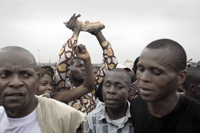
Guy Tillim, Supporters of Jean-Pierre Bemba mock President Kabila, calling him an egg seller, 2006; courtesy Michael Stevenson Gallery; SFMOMA Accessions Committee Fund; © Guy Tillim
From January 31 through April 26, 2009, the San Francisco Museum of Modern Art (SFMOMA) will present Face of Our Time: Four Shows―Yto Barrada, Guy Tillim, Judith Joy Ross, Leo Rubinfien, a photography exhibition of four individual shows featuring the work of four distinctive artists, aligned because they each share an interest in making pictures about the current condition of our world. SFMOMA Senior Curator of Photography Sandra S. Phillips says, “We are pleased to present this major work by these important artists who are contemplating the kind of world we live in—what it looks like and what it reveals to us about the lives we lead.”
The exhibition’s title is a reference to the great work of German photographer August Sander and his first book, People of the 20th Century, published in 1929. Sander, who took pictures primarily between World Wars I and II, had an interest in recording his country’s culture through the types of people it comprised, from the stalwart peasants in the countryside and the pastry chef in the city to the wealthy industrialist. He proposed to show current German history, in all its social range, through portraits of the German people. The artists in Face of Our Time each share Sander’s powerful talent for looking at the world, seeing ordinary people, and finding in these real moments a larger understanding of the complexities of the world today.
Yto Barrada looks at the transformations occurring around her home in northern Morocco, which abuts the Strait of Gibraltar and faces the Mediterranean Sea. Where the Mediterranean was once the center of European culture, it is now a barrier to the more prosperous countries in Europe. For instance, in one of Barrada’s pictures we see the interior of a modest café, the oilcloths gleaming on the tables, and beyond, the sea outside, a view of Europe faintly visible. Her photographs also study the transformation of northern Morroco into a tourist destination, uprooting families, corrupting the longstanding culture, and disrupting the landscape. Though many of her pictures contain people, the faces of Barrada’s subjects are often directed away from the lens, evoking a sense of departure, and the faded, muted colors in her photographs impart a gentle sadness in witnessing these changes.
Guy Tillim began working as a freelance media photographer in 1986 and has moved from classical photojournalism to making pictures with less obvious rhetoric: they suggest ambivalences rather than certain truths. Tillim, who currently lives in Cape Town, has focused his attention on the changes occurring in contemporary Africa. For Face of Our Time, he will be showing two recent projects, Congo Democratic and Petros Village. The former is a collection of photographs taken during the 2006 elections in the Congo Republic. While the photos are clearly informed by Tillim’s committed attention to the political events in Africa, their subjects are not so much the actual events around the elections as the palpable sense of restlessness and the immense impulse to invoke change—even though the attempt might be futile. All of this palpable intensity occurs within the landscape of a poor and grimy city, in an evocatively smoky atmosphere. The second project focuses on the people who live a small community in Malawi. Tillim’s pictures show an almost ideal African village, one where concepts of community are being challenged by global changes that are beyond the villagers’ understanding and control.
For more than two decades, Judith Joy Ross has been photographing children, either in school or during vacations, and adults who are often involved in political situations, such as her famous series of pictures of visitors to the Vietnam Veterans War Memorial in Washington D.C. Her pictures seem at first to be artless, even incidental, though they are genuinely deliberative, and mostly made with an old-fashioned large view camera, like the pictures of Walker Evans whom she admires, along with August Sander. The pictures in the present show entitled Protest the War, depicts demonstrators against the present conflict in Iraq. Unlike the more heroic demonstrations of civil protest in the past—such as those that took place during the Civil Rights era, here we find only a few who have joined the ranks—and they are both young and gentle idealists, or older retirees. They pay homage to these ordinary people brave enough to stand up for their beliefs, which sustain them as their presence confounds those busy people who drive by them, wondering what they are doing this for.
Working within the tradition of street photography, Leo Rubinfien’s latest project, Wounded Cities, consists of large-scale black-and-white photographs taken in cities that have recently experienced terrorist attacks—or to use his term, “freelance warfare.” Like the other artists in this exhibition, his aim was not to document but to evoke a sense of what it is like to live in the era of terrorism; places such as New York, London, Cairo, Madrid, Tel Aviv, and Jakarta are included in this horrible index to the insecurities of contemporary life worldwide. By photographing anonymous people seen by chance in city streets, Rubinfien reflects on a new vulnerability we all now share. He writes: “Here were people who’d been forced to see their own mortality, which perhaps, like me, they had apprehended only partly, or poorly, or too hastily, slamming the door on it as soon as they’d taken the least possible look….Something else suggested now that it was the important thing: how—having been faced with what they had wanted not to see—how they prepared themselves. How beautifully, or with what respectful attention, or how bravely, perhaps, they offered themselves back. “
Face of Our Time is organized by San Francisco Museum of Modern Art Senior Curator of Photography, Sandra S. Phillips. For additional information, please visit www.sfmoma.org.